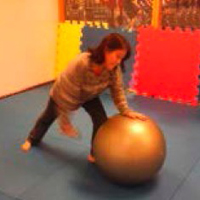Strengthening exercises using swiss ball improve pain, health status, quality of life and muscle strength in patients with fibromyalgia: a randomized controlled trial

Submitted: 24 September 2020
Accepted: 22 January 2021
Published: 19 April 2021
Accepted: 22 January 2021
Abstract Views: 9516
PDF: 3868
Publisher's note
All claims expressed in this article are solely those of the authors and do not necessarily represent those of their affiliated organizations, or those of the publisher, the editors and the reviewers. Any product that may be evaluated in this article or claim that may be made by its manufacturer is not guaranteed or endorsed by the publisher.
All claims expressed in this article are solely those of the authors and do not necessarily represent those of their affiliated organizations, or those of the publisher, the editors and the reviewers. Any product that may be evaluated in this article or claim that may be made by its manufacturer is not guaranteed or endorsed by the publisher.
Similar Articles
- A. Romeo, S. Parazza, M. Boschi, T. Nava, C. Vanti, Manual therapy and therapeutic exercise in the treatment of osteoarthritis of the hip: a systematic review , Reumatismo: Vol. 65 No. 2 (2013)
- A. Loi, S. Lisci, A. Denotti, A. Cauli, Bone mineral density in women on long-term mud-bath therapy in a Salus per Aquam (SPA) environment , Reumatismo: Vol. 65 No. 3 (2013)
- S. Canestri, M.C. Totaro, E. Serone, B. Tolusso, D. Frezza, E. Gremese, G. Ferraccioli, Association between the response to B cell depletion therapy and the allele*2 of the HS1,2A enhancer in seropositive rheumatoid arthritis patients , Reumatismo: Vol. 64 No. 6 (2012)
- S.L. Bello, L. Serafino, C. Bonali, N. Terlizzi, C. Fanizza, C. Anecchino, G. Lapaldula, Incidence of influenza-like illness into a cohort of patients affected by chronic inflammatory rheumatism and treated with biological agents , Reumatismo: Vol. 64 No. 5 (2012)
- A. Minelli, A. Vaona, Effectiveness of cognitive behavioral therapy in the treatment of fibromyalgia syndrome: a meta-analytic literature review , Reumatismo: Vol. 64 No. 3 (2012)
- M. Romano, I. Pontikaki, M. Gattinara, I. Ardoino, C. Donati, P. Boracchi, P.L. Meroni, V. Gerloni, Drug survival and reasons for discontinuation of the first course of biological therapy in 301 juvenile idiopathic arthritis patients , Reumatismo: Vol. 65 No. 6 (2013)
- S. Iervolino, M. Lofrano, M.N.D. Di Minno, F. Foglia, R. Scarpa, R. Peluso, IgA deficiency evidence after anti-TNF-α treatment in a psoriatic arthritis patient: case report , Reumatismo: Vol. 64 No. 1 (2012)
- C. Chatzigeorgiou, S.L. Mackie, Comorbidity in polymyalgia rheumatica , Reumatismo: Vol. 70 No. 1 (2018): Monographic issue on Polymyalgia Rheumatica
- F. Salaffi, A. Ciapetti, P. Sarzi Puttini, F. Atzeni, C. Iannuccelli, M. Di Franco, M. Cazzola, L. Bazzichi, Preliminary identification of key clinical domains for outcome evaluation in fibromyalgia using the Delphi method: the Italian experience , Reumatismo: Vol. 64 No. 1 (2012)
- M. de Oliveira Paes Leme, S.L.K. Yuan, M. Oliveira Magalhães, S.R. Ferreira de Meneses, A.P. Marques, Pain and quality of life in knee osteoarthritis, chronic low back pain and fibromyalgia: a comparative cross-sectional study , Reumatismo: Vol. 71 No. 2 (2019)
You may also start an advanced similarity search for this article.

 https://doi.org/10.4081/reumatismo.2021.1357
https://doi.org/10.4081/reumatismo.2021.1357




